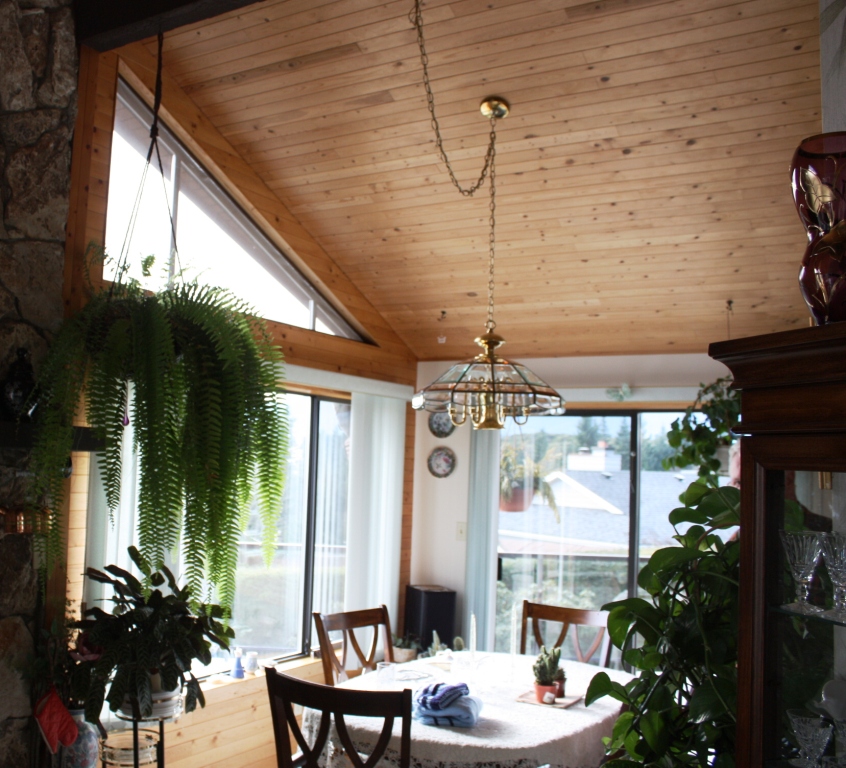How Solar Blinds Work
NASA initially developed Reflective Foil Radiant Barriers to facilitate space travel. Aluminum reflects over 80% of radiant heat. Radiant heat accounts for the majority of heat transfer, especially through windows. Utilising aluminum and now carbon materials this heat reflecting and heat absorbing technology is now available to you for your windows.
This video of one of the manufacturers will show you how it works and how it can make your home more energy efficient:
Solar blinds remove most of the glare in the summer, reducing the amount of heat blasting into your home or office, and in the winter they are solar heat collectors that simultaneously reflect your heat back inside!
These products are priced competitively to other good quality blinds while also having a vastly superior energy performance to any other type of blind or other window products. They work very well in skylights, too! Unlike other insulating blinds the occupants can still see outside. Call us for a quote.
Why is this technology so important to your home? It is the most effective system available to address the least energy efficient part of your building – The Window/Skylight. It has been proven that windows (and especially skylights) are the weakest link in the insulation value of most homes and offices. Windows/skylights lose valuable heat through radiation, conduction, convection and draft heat losses (and gains). These blinds vastly improve the performance of your existing windows and skylights, saving you money and making your home or office more comfortable.
Save up to 40% on your energy bills!
The removable, reversible, see-through solar blinds and panels address all of the seasonal changes throughout the year by keeping the heat in during the winter and keeping the heat from escaping during the summer. It’s a great permanent solution for high energy bills.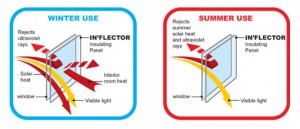
Winter Benefits and Value
In the winter the solar blinds are placed so that the silver or white side is facing inward, reflecting the thermal heat back into the building. Also adding conductive and convective insulation these products reduce heat losses through the windows and skylights. Windows/skylights that have direct exposure to the sun benefit from having the black side of the product facing outward, acting as a passive solar collector that absorbs the suns rays and radiates the inside heat back inside!
Solar blinds reduce your heating and cooling requirements, saving you money!
As an example, a 1.2m X 1.2m window in direct sunlight can produce 1500 BTU’s of heat per hour in Canada, which is equivalent to a 400 watt electric heater. Meanwhile the damaging UV rays are reflected back outside. Thus the solar blinds reduce the load, wear and maintenance on HVAC (heating/cooling) systems, saving you even more money and hassle.
Summer Benefits and Value
In the summer the solar blinds are positioned so that the silver or white side faces out and reflects more than 70% of the radiant heat back out through the window or skylight (reducing the greenhouse effect in buildings). These also greatly reduce the glare inside.
Not only do they reduce summertime overheating in buildings, they pack other benefits as well. They:
- reflect more than 90% of damaging UV rays back out through the windows (reducing fading & sun damage on your carpets and furniture),
- greatly reduce glare (especially helpful when using computers or watching TV),
- provide daytime privacy (one way vision),
- provide cool day lighting with a view,
- reduce the load, wear, & maintenance on HVAC units. It reduces cooling requirements which reduces energy consumption, saving you money.
Actual Solar Blind Evaluations
1. The following performance tests consists of a 250W heat lamp reaching a temperature of 400º with an In’flector panel placed between two thermometer sensors.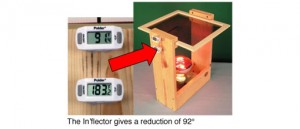
2. How much heat passes through different types of glass and how much of a difference would adding a solar blind actually make in homes and offices?
Let us show you a demonstration to show you how it works! The EDTM glass testing equipment (EDTM is a National Fenestration Rating Council certified manufacture of glass testing equipment) enables us to demonstrate three important effects: how much heat passes through different types of glass, how much heat passes through the panel, and how window efficiency is improved with the these products. The equipment used for the test: EDTM heat lamp 1-0D784-85-00 and EDTM Solar Transmission & Btu Power Meter Model # 2065.
THE CALIBRATION: The EDTM solar Transmission & BTU Power Meter Model #2065 was calibrated where the heat measured at the meter was at 100%, each piece of glass was positioned between lamp and the meter and the metered results recorded.
Types of glass tested:

The glass samples were positioned between the source of heat (heat lamp) and the solar meter which measured what percentage of heat moved through the different types of glass.
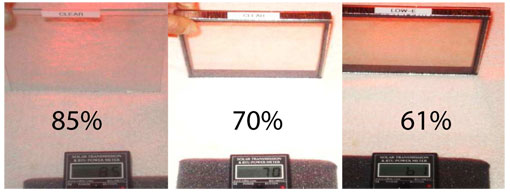
The above metered measurements were recorded showing the amount of heat which passes through each type of glass.
Single Pane Clear: 85% of the heat passes through the glass.
Double Pane Clear: 70% of the heat passes through the glass.
Double Pane Low-E: 61% of the heat passes through the glass.
With the meter calibrated and registering 100 % of heat from the lamp, the solar panel was placed between the source of the heat (the heat lamp) and the meter in the same placement as the glass samples.
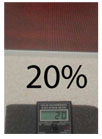
The meter reading with just the In’Flector material shows only 20 % of the heat actually reaching the meter. Laboratory tests report the this material reflects 72% of radiant heat, and 65 % of solar heat.
be covered at the nighttime unless indoor privacy is desired. These products costs less as they use a carbon material. They also do not burn.
Laboratory testing of the In’flector
Yellot Solar Laboratories reported the following results: “Through in depth laboratory tests of In’Flector Insulators it was established that ‘A four foot square window (with In’Flector Insulators in the winter configuration) would have a heat gain of 2096 Btu/hr, which is equivalent to a 600 watt electric heater.’”
In’Flector was tested using ASHRAE Standard Number 74-73 at the Yellot Solar Energy Laboratory.
“In’Flector Insulators can be a source of free heat during cold but clear winter days. In this configuration the In’Flector are also reflecting the heat away from the cold conductive window glass. This can represent much added comfort while reducing heating costs.”
Insulation
Texas A&M University Results
From a 2002 report titled Effects of the In’Flector Solar Screens on the Thermal Properties of Windows, “Specifically, the U value of the glazing improved by an average of 54% for the winter condition and 50% for the summer condition.” (Window energy efficiency is measured in “U” values.)
Tested
The Department of Construction Science under the guidance of Keith Sylvester, Ph.D, Associate AIA, Texas A&M University
Impact on Consumer
“In’Flector will improve the insulation value of any window. Coupled with the numerous other benefits, In’Flector improves the comfort and energy savings of any home or building.”
6. Solar Gain Reduction
EDTM Glass Testing Equipment
Results
EDTM makes glass testing equipment used by the National Fenestration Rating Council. Using the EDTM Solar Transmission and Btu Power Meter (model #SP2065) and comparing un-insulated and In’Flector Insulated windows, it can be shown that In’Flector Window Insulators are twice as effective as new low e windows for reducing solar gain.
Tested
Single pane, plate, double pane, and low e windows were all tested. In’Flector alone outperformed all window type
s for both solar gain reduction and UV’s rejection. When used in conjunction with single pane glass, In’Flector outperformed any of the above window types.
The following 3 minute video explains how the In’Flector product works in a home or office.
In this application the solar blind was installed on the formerly uncovered upper rectangular windows of this south-facing home, greatly reducing the summer-time heating. These Nanaimo customers are very satisfied, as they had not been able to use their kitchen and dining rooms before the panels were installed (too hot!), and they are also saving lost heat in the wintertime while still capturing the sun’s heat.
Conclusions. Solar gain and loss is a major consideration of good building envelopes. Thermal transmittance properties can be greatly improved on any window or skylight with the addition of a solar blind or panel.
Solar blinds help create a more energy efficient, comfortable, money and furniture-saving home or office.
Do contact us for a free consultation.
